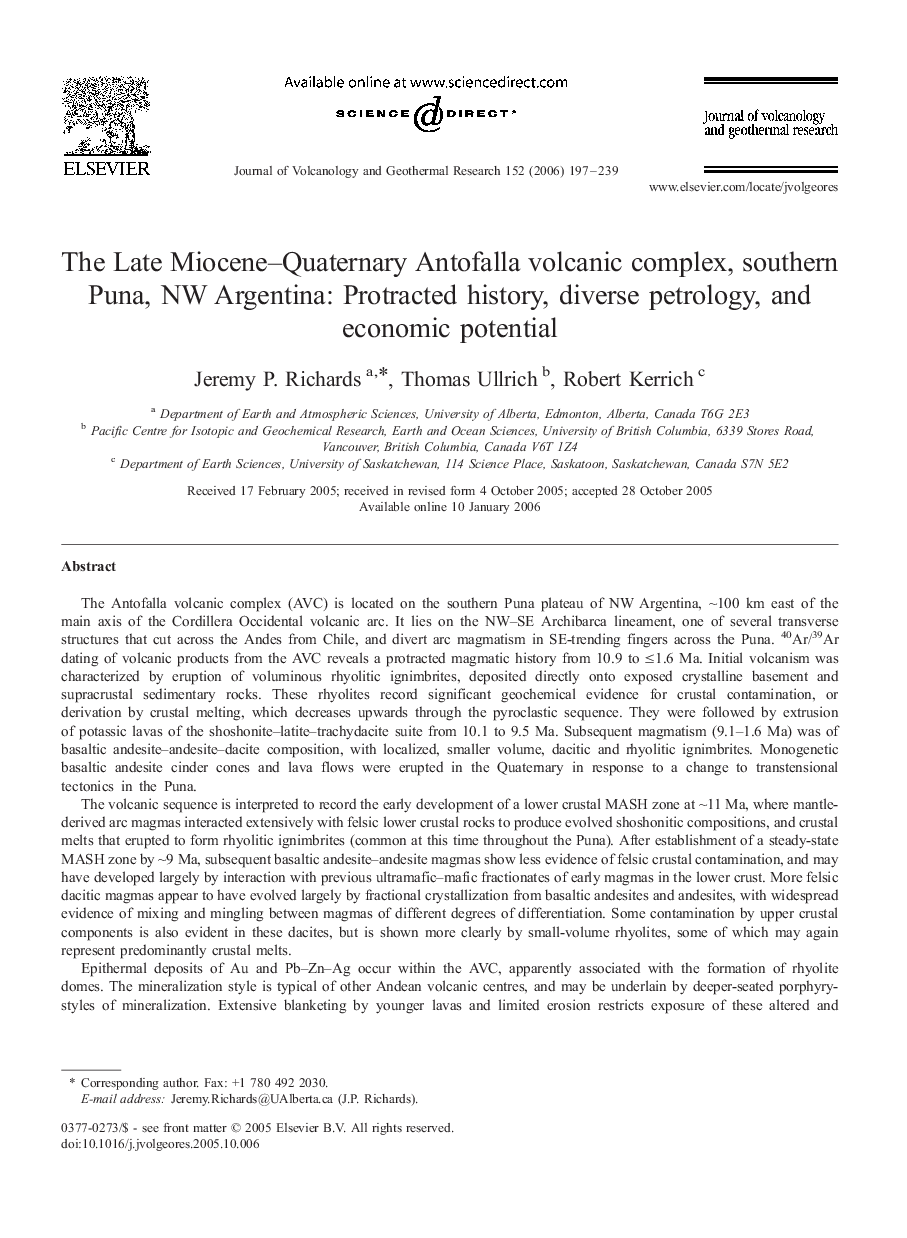| کد مقاله | کد نشریه | سال انتشار | مقاله انگلیسی | نسخه تمام متن |
|---|---|---|---|---|
| 4715113 | 1638481 | 2006 | 43 صفحه PDF | دانلود رایگان |

The Antofalla volcanic complex (AVC) is located on the southern Puna plateau of NW Argentina, ∼100 km east of the main axis of the Cordillera Occidental volcanic arc. It lies on the NW–SE Archibarca lineament, one of several transverse structures that cut across the Andes from Chile, and divert arc magmatism in SE-trending fingers across the Puna. 40Ar/39Ar dating of volcanic products from the AVC reveals a protracted magmatic history from 10.9 to ≤ 1.6 Ma. Initial volcanism was characterized by eruption of voluminous rhyolitic ignimbrites, deposited directly onto exposed crystalline basement and supracrustal sedimentary rocks. These rhyolites record significant geochemical evidence for crustal contamination, or derivation by crustal melting, which decreases upwards through the pyroclastic sequence. They were followed by extrusion of potassic lavas of the shoshonite–latite–trachydacite suite from 10.1 to 9.5 Ma. Subsequent magmatism (9.1–1.6 Ma) was of basaltic andesite–andesite–dacite composition, with localized, smaller volume, dacitic and rhyolitic ignimbrites. Monogenetic basaltic andesite cinder cones and lava flows were erupted in the Quaternary in response to a change to transtensional tectonics in the Puna.The volcanic sequence is interpreted to record the early development of a lower crustal MASH zone at ∼11 Ma, where mantle-derived arc magmas interacted extensively with felsic lower crustal rocks to produce evolved shoshonitic compositions, and crustal melts that erupted to form rhyolitic ignimbrites (common at this time throughout the Puna). After establishment of a steady-state MASH zone by ∼9 Ma, subsequent basaltic andesite–andesite magmas show less evidence of felsic crustal contamination, and may have developed largely by interaction with previous ultramafic–mafic fractionates of early magmas in the lower crust. More felsic dacitic magmas appear to have evolved largely by fractional crystallization from basaltic andesites and andesites, with widespread evidence of mixing and mingling between magmas of different degrees of differentiation. Some contamination by upper crustal components is also evident in these dacites, but is shown more clearly by small-volume rhyolites, some of which may again represent predominantly crustal melts.Epithermal deposits of Au and Pb–Zn–Ag occur within the AVC, apparently associated with the formation of rhyolite domes. The mineralization style is typical of other Andean volcanic centres, and may be underlain by deeper-seated porphyry-styles of mineralization. Extensive blanketing by younger lavas and limited erosion restricts exposure of these altered and mineralized sequences, however, although the potential for further discoveries beneath cover or at depth in this system appears high.
Journal: Journal of Volcanology and Geothermal Research - Volume 152, Issues 3–4, 15 April 2006, Pages 197–239